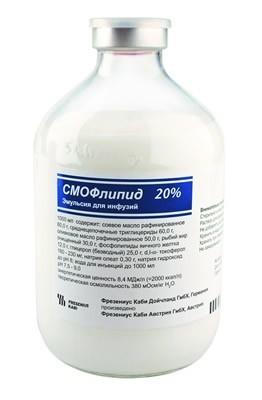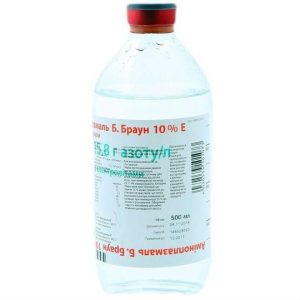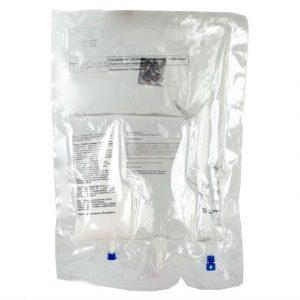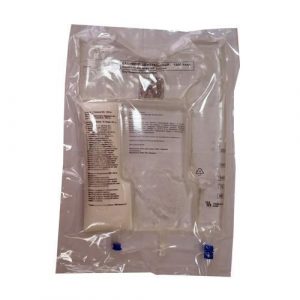Description
Packing
Bottle 100 ml.
Pharmacological action
SMOFlipid – supplementing the deficiency of essential fatty acids, compensating for the deficiency of energy substrates in the body.
Pharmacodynamics
CMOFlipid is identical in particle size and biological properties to endogenous chylomicrons. The components of the drug – soybean oil, medium chain triglycerides, olive oil and fish oil – in addition to differences in composition and energy value, have their own pharmacodynamic properties.
Soybean oil contains a large amount of essential fatty acids. It is most rich in linoleic acid (approximately 55-60%), which is a -6-fatty acid. 8% of the composition of soybean oil is represented by -Linolenic acid, which is -3-fatty acid. This part of the drug provides the necessary amount of essential fatty acids.
Medium chain fatty acids provide the body with rapidly available energy due to their ability to oxidize rapidly.
Olive oil supplies energy in the form of monounsaturated fatty acids, which are much less susceptible to oxidation compared to the corresponding amount of PUFA.
Fish oil is high in eicosapentaenoic (EPA) and docosahexaenoic (DHA) acids. DHA is an important structural component of cell membranes, and EPA is a precursor to eicosanoids such as PG, thromboxanes and LT.
Vitamin E protects unsaturated fatty acids from peroxidation.
Pharmacokinetics
Various triglycerides in the composition of the drug SMOFlipid have different indicators of clearance, but SMOFlipid, on average (as a mixture), is eliminated faster than long chain tryglycerides (LCT). The lowest clearance of all components is in olive oil (slightly lower than that of LCT), and the highest clearance is in medium chain triglycerides (MCT). Fish oil in an LCT mixture has the same clearance as pure LCT.
Indications
Complete or partial parenteral nutrition as a source of energy and essential fatty acids including U-3 fatty acids, when oral or enteral nutrition is impossible, insufficient or contraindicated the prevention and treatment of insufficiency (deficiency) of essential fatty acids, including -3 fatty acids.
Contraindications
hypersensitivity to fish proteins, eggs, soybeans, peanuts or components of the
preparation severe hyperlipidemia
severe liver failure
severe coagulation disorders
severe renal failure severe senility decompensated diabetes mellitus, acute myocardial infarction, stroke, embolism, metabolic acidosis, severe sepsis, hypotonic dehydration).
pulmonary edema
hyperhydration
decompensated heart failure.
Precautions: impaired fat metabolism, which can be observed in patients with renal failure, diabetes mellitus, pancreatitis, impaired liver function, hypothyroidism and sepsis. Clinical experience with the use of SMOFlipid in patients with diabetes mellitus and renal failure is limited.
Composition
Active ingredients: soybean oil (refined) 60 g, medium chain triglycerides 60 g, olive oil (refined) 50 g, purified fish oil 30 g
Dosage and Administration
For infusion into a central or peripheral vein. The dose and rate of infusion should be determined by the patient’s ability to eliminate intravenously administered lipids. The standard dose is 1-2 g of fat / kg body weight / day, which corresponds to 5-10 ml of the drug / kg / day.
Maximum daily dose: 2 g fat / kg / day, which corresponds to 10 ml of the drug / kg / day.
The recommended infusion rate is 0.125 g fat / kg body weight / h, which corresponds to 0.63 ml of CMOFlipid / kg body weight / h. The infusion rate should not exceed 0.15 g fat / kg body weight / h, which corresponds to 0.75 ml of SMOFlipid / kg body weight / h.
Side effects
From the respiratory system, chest and mediastinal organs: rarely – shortness of breath.
From the gastrointestinal tract: infrequently – loss of appetite, nausea, vomiting.
From the vessels: rarely – lowering blood pressure, increased blood pressure.
General disorders and disorders at the injection site: often – mild fever rarely – chills rarely – hypersensitivity reactions (anaphylactic and anaphylactoid reactions, skin rash, urticaria, hyperemia, headache), sensation of warmth or cold, pallor, cyanosis, pain in the neck, chest and lower back.
From the genitals and mammary glands: very rarely – priapism.
Drug Interactions
Clinical use of heparin causes a transient increase in lipoprotein lipase secretion into the bloodstream. At first, this can lead to an increase in plasma lipolysis, and then to a temporary decrease in the clearance of triglycerides.
Soybean oil is a source of natural vitamin K1. However, the content of this vitamin in the SMOFlipid preparation does not significantly affect the blood coagulation process in patients who received treatment with indirect anticoagulants – coumarin derivatives.
Adding other medications or drugs to the SMOFlipid emulsion is usually not recommended, unless proven to be compatible.
SMOFlipid can be mixed with fat-soluble (Vitalipid) and water-soluble (Soluvit) vitamins.
SMOFlipid under aseptic conditions can be mixed with solutions of amino acids, glucose and electrolytes to obtain a solution for parenteral nutrition “all in one”.
When prescribing SMOFlipid with other infusion media (e.g. amino acid solutions, glucose) through the usual system for iv infusions, the compatibility of the solutions and emulsions used must be guaranteed.
Overdose
Reduced ability to eliminate triglycerides can lead to the development of fat overload syndrome, which can be caused by an overdose of any fat emulsions. It is necessary to pay attention to possible signs of metabolic overload. The causes of impaired lipid metabolism can be genetic (an individual difference in metabolism), in addition, present or previous diseases can affect fat metabolism. This syndrome can also develop during severe hypertriglyceridemia, even at the recommended infusion rate, and may be accompanied by a sudden change in the patient s clinical condition, such as renal failure or infection. Fat overload syndrome is characterized by hyperlipemia, fever, fatty infiltration, hepatomegaly with or without jaundice, splenomegaly, leukopenia, thrombocytopenia, blood clotting disorders, hemolysis, reticulocytosis, pathological results of functional liver tests and the development of coma. Stopping the infusion of the fat emulsion leads to the disappearance of all symptoms.
Storage Conditions
In a dry, dark place, at a temperature not exceeding 20 ° C.
Expiration
2 years.
active substance
amino acids for parenteral nutrition
Fresenius Kabi, Germany




